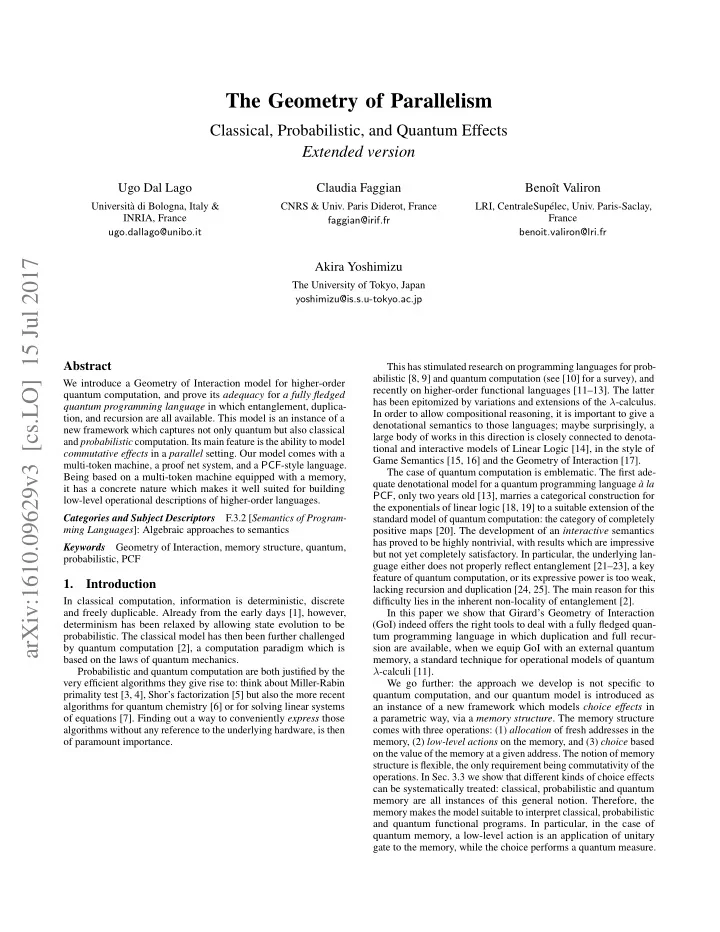

The Geometry of Parallelism Classical, Probabilistic, and Quantum Effects Extended version Ugo Dal Lago Claudia Faggian Benoˆ ıt Valiron Universit` a di Bologna, Italy & CNRS & Univ. Paris Diderot, France LRI, CentraleSup´ elec, Univ. Paris-Saclay, INRIA, France France faggian@irif.fr ugo.dallago@unibo.it benoit.valiron@lri.fr arXiv:1610.09629v3 [cs.LO] 15 Jul 2017 Akira Yoshimizu The University of Tokyo, Japan yoshimizu@is.s.u-tokyo.ac.jp Abstract This has stimulated research on programming languages for prob- abilistic [ 8 , 9 ] and quantum computation (see [ 10 ] for a survey), and We introduce a Geometry of Interaction model for higher-order recently on higher-order functional languages [ 11 – 13 ]. The latter quantum computation, and prove its adequacy for a fully fledged has been epitomized by variations and extensions of the λ -calculus. quantum programming language in which entanglement, duplica- In order to allow compositional reasoning, it is important to give a tion, and recursion are all available. This model is an instance of a denotational semantics to those languages; maybe surprisingly, a new framework which captures not only quantum but also classical large body of works in this direction is closely connected to denota- and probabilistic computation. Its main feature is the ability to model tional and interactive models of Linear Logic [ 14 ], in the style of commutative effects in a parallel setting. Our model comes with a Game Semantics [15, 16] and the Geometry of Interaction [17]. multi-token machine, a proof net system, and a PCF -style language. The case of quantum computation is emblematic. The first ade- Being based on a multi-token machine equipped with a memory, quate denotational model for a quantum programming language ` a la it has a concrete nature which makes it well suited for building PCF , only two years old [ 13 ], marries a categorical construction for low-level operational descriptions of higher-order languages. the exponentials of linear logic [ 18 , 19 ] to a suitable extension of the Categories and Subject Descriptors F.3.2 [ Semantics of Program- standard model of quantum computation: the category of completely ming Languages ]: Algebraic approaches to semantics positive maps [ 20 ]. The development of an interactive semantics has proved to be highly nontrivial, with results which are impressive Keywords Geometry of Interaction, memory structure, quantum, but not yet completely satisfactory. In particular, the underlying lan- probabilistic, PCF guage either does not properly reflect entanglement [ 21 – 23 ], a key feature of quantum computation, or its expressive power is too weak, 1. Introduction lacking recursion and duplication [ 24 , 25 ]. The main reason for this In classical computation, information is deterministic, discrete difficulty lies in the inherent non-locality of entanglement [2]. and freely duplicable. Already from the early days [ 1 ], however, In this paper we show that Girard’s Geometry of Interaction determinism has been relaxed by allowing state evolution to be (GoI) indeed offers the right tools to deal with a fully fledged quan- probabilistic. The classical model has then been further challenged tum programming language in which duplication and full recur- by quantum computation [ 2 ], a computation paradigm which is sion are available, when we equip GoI with an external quantum based on the laws of quantum mechanics. memory, a standard technique for operational models of quantum λ -calculi [11]. Probabilistic and quantum computation are both justified by the very efficient algorithms they give rise to: think about Miller-Rabin We go further: the approach we develop is not specific to primality test [ 3 , 4 ], Shor’s factorization [ 5 ] but also the more recent quantum computation, and our quantum model is introduced as algorithms for quantum chemistry [ 6 ] or for solving linear systems an instance of a new framework which models choice effects in of equations [ 7 ]. Finding out a way to conveniently express those a parametric way, via a memory structure . The memory structure algorithms without any reference to the underlying hardware, is then comes with three operations: (1) allocation of fresh addresses in the of paramount importance. memory, (2) low-level actions on the memory, and (3) choice based on the value of the memory at a given address. The notion of memory structure is flexible, the only requirement being commutativity of the operations. In Sec. 3.3 we show that different kinds of choice effects can be systematically treated: classical, probabilistic and quantum memory are all instances of this general notion. Therefore, the memory makes the model suitable to interpret classical, probabilistic and quantum functional programs. In particular, in the case of quantum memory, a low-level action is an application of unitary gate to the memory, while the choice performs a quantum measure.
Recommend
More recommend